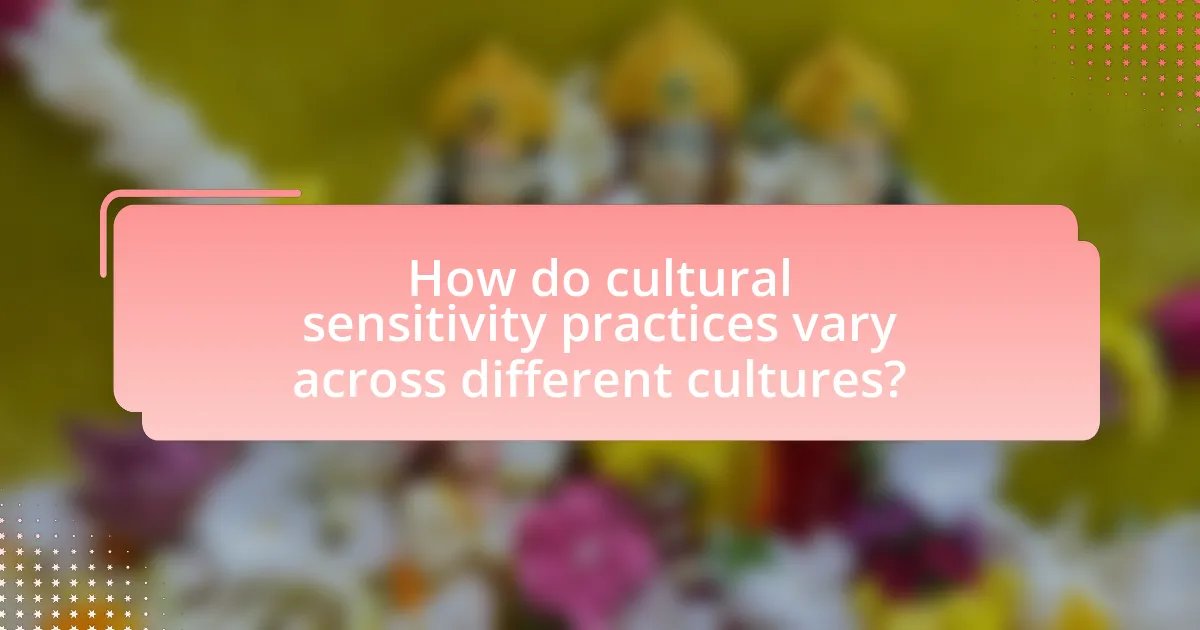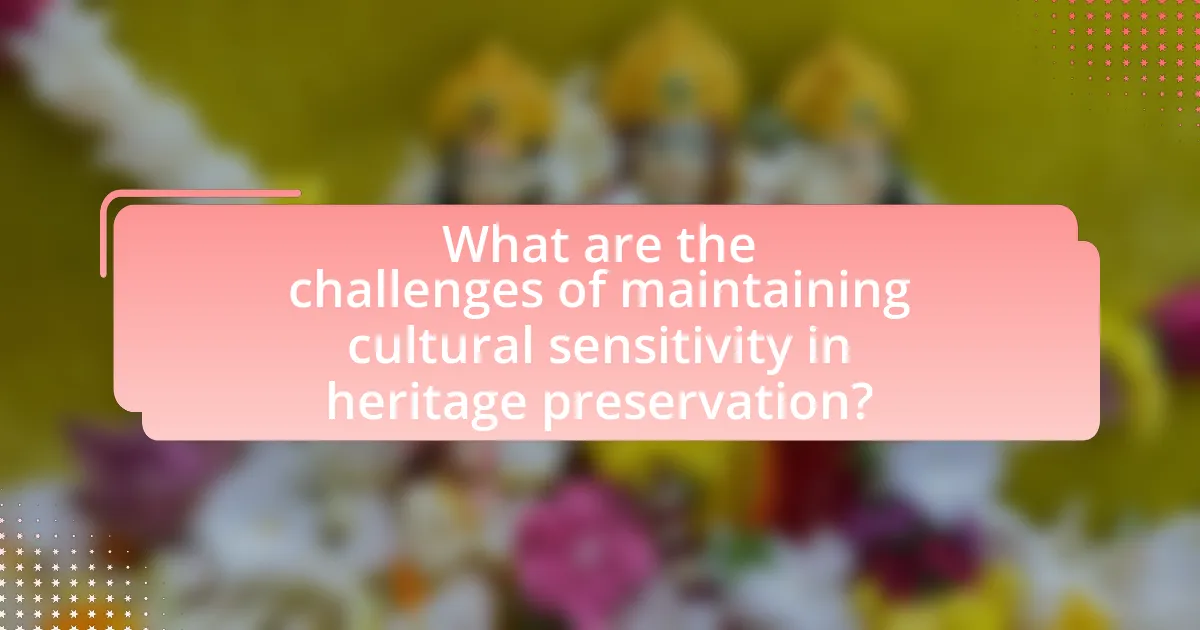Cultural sensitivity in heritage preservation practices emphasizes the importance of respecting and integrating the cultural values, beliefs, and traditions of local communities in preservation efforts. This approach fosters community engagement, ownership, and collaboration, which are essential for the sustainability of heritage sites. The article discusses the significance of cultural sensitivity, the potential consequences of neglecting it, and the key principles that guide preservation efforts, including community involvement and recognition of diverse cultural narratives. Additionally, it explores the challenges faced in implementing these practices, the role of local knowledge, and the impact of technology in enhancing cultural sensitivity in heritage preservation.

What is Cultural Sensitivity in Heritage Preservation Practices?
Cultural sensitivity in heritage preservation practices refers to the awareness and respect for the cultural values, beliefs, and traditions of communities when preserving their heritage. This approach ensures that preservation efforts are inclusive and considerate of the perspectives and needs of local populations, thereby fostering collaboration and mutual respect. For instance, the UNESCO World Heritage Convention emphasizes the importance of involving local communities in the decision-making processes related to their cultural heritage, recognizing that their input is vital for authentic preservation.
Why is cultural sensitivity important in heritage preservation?
Cultural sensitivity is important in heritage preservation because it ensures that the values, beliefs, and practices of the communities associated with the heritage are respected and integrated into preservation efforts. This respect fosters community engagement and ownership, which are crucial for the sustainability of heritage sites. For instance, the UNESCO Convention on the Means of Prohibiting and Preventing the Illicit Import, Export and Transfer of Ownership of Cultural Property emphasizes the need for cultural sensitivity in protecting cultural heritage, highlighting that local communities should be involved in decision-making processes. Engaging with local perspectives not only enhances the authenticity of preservation efforts but also helps to prevent conflicts and promotes social cohesion.
What are the potential consequences of ignoring cultural sensitivity?
Ignoring cultural sensitivity can lead to significant negative consequences, including the alienation of communities, loss of cultural heritage, and potential conflicts. When cultural sensitivity is disregarded, marginalized groups may feel disrespected and excluded, resulting in a breakdown of trust and collaboration. This alienation can hinder effective heritage preservation efforts, as local communities often hold vital knowledge and emotional connections to their cultural sites. Furthermore, the lack of cultural sensitivity can result in the destruction or alteration of culturally significant sites, leading to irreversible loss of heritage. Historical examples, such as the destruction of the Buddhas of Bamiyan in Afghanistan, illustrate how neglecting cultural values can provoke international outrage and conflict. Thus, the consequences of ignoring cultural sensitivity are profound, affecting both social cohesion and the preservation of cultural identity.
How does cultural sensitivity enhance community engagement?
Cultural sensitivity enhances community engagement by fostering trust and respect between diverse groups. When community initiatives are designed with an understanding of cultural values and practices, they encourage participation from all community members. For example, research by the National Endowment for the Arts indicates that culturally sensitive programs lead to higher attendance and involvement rates, as individuals feel their identities are acknowledged and valued. This inclusive approach not only strengthens community ties but also promotes collaborative efforts in heritage preservation, ensuring that diverse perspectives are integrated into decision-making processes.
What are the key principles of cultural sensitivity in heritage preservation?
The key principles of cultural sensitivity in heritage preservation include respect for local traditions, community involvement, and recognition of diverse cultural narratives. Respect for local traditions ensures that preservation efforts honor the values and practices of the communities connected to the heritage site. Community involvement emphasizes the importance of engaging local stakeholders in decision-making processes, which fosters a sense of ownership and responsibility towards the heritage. Recognition of diverse cultural narratives acknowledges that multiple perspectives exist regarding the significance of heritage, promoting inclusivity and understanding among different cultural groups. These principles are essential for effective and ethical heritage preservation, as they help to maintain the integrity and relevance of cultural sites.
How do these principles guide preservation efforts?
Cultural sensitivity principles guide preservation efforts by ensuring that the values, beliefs, and practices of local communities are respected and integrated into the preservation process. These principles advocate for the involvement of indigenous and local populations in decision-making, which fosters a sense of ownership and responsibility towards heritage sites. For instance, the UNESCO Convention on the Protection of the World Cultural and Natural Heritage emphasizes the importance of community engagement in the preservation of cultural heritage, highlighting that successful preservation requires understanding and honoring the cultural significance of sites to the communities they belong to. This approach not only enhances the effectiveness of preservation efforts but also promotes sustainable practices that align with the cultural identity of the community.
What role does local knowledge play in these principles?
Local knowledge is essential in cultural sensitivity principles for heritage preservation as it ensures that the values, traditions, and practices of the community are respected and integrated into preservation efforts. This knowledge provides insights into the historical significance and cultural context of heritage sites, which can lead to more effective and meaningful preservation strategies. For instance, studies have shown that involving local communities in the decision-making process enhances the sustainability of preservation projects and fosters a sense of ownership, as evidenced by successful initiatives in various regions where local input has led to improved outcomes in heritage conservation.

How do cultural sensitivity practices vary across different cultures?
Cultural sensitivity practices vary significantly across different cultures, reflecting diverse values, beliefs, and social norms. For instance, in Indigenous cultures, practices often emphasize community involvement and respect for ancestral knowledge, as seen in the collaborative efforts of Native American tribes in preserving sacred sites. In contrast, Western cultures may prioritize individual rights and legal frameworks, leading to a focus on documentation and regulatory compliance in heritage preservation. Research by the International Council on Monuments and Sites highlights that cultural sensitivity in heritage practices must adapt to local contexts, ensuring that preservation efforts align with the cultural identities and historical narratives of the communities involved.
What are some examples of culturally sensitive preservation practices?
Culturally sensitive preservation practices include community engagement, traditional knowledge integration, and adaptive reuse of heritage sites. Community engagement involves collaborating with local populations to ensure their values and traditions are respected in preservation efforts, as seen in projects like the revitalization of Indigenous cultural sites in Canada. Traditional knowledge integration incorporates local customs and practices into preservation strategies, exemplified by the use of Indigenous fire management techniques in Australian land management. Adaptive reuse of heritage sites allows for the preservation of cultural significance while meeting contemporary needs, such as transforming historic buildings into community centers or museums, which has been successfully implemented in cities like New York and London. These practices demonstrate a commitment to honoring cultural identities while ensuring the sustainability of heritage sites.
How do these practices reflect the values of specific communities?
Heritage preservation practices reflect the values of specific communities by prioritizing their cultural identity, historical significance, and social cohesion. These practices often involve community engagement, ensuring that local voices and traditions are respected and integrated into preservation efforts. For instance, the inclusion of indigenous perspectives in the preservation of sacred sites demonstrates a commitment to honoring ancestral knowledge and cultural heritage. Research by the National Park Service highlights that community-led initiatives in heritage preservation not only enhance cultural pride but also foster a sense of belonging and responsibility among community members.
What challenges arise when implementing these practices in diverse settings?
Implementing cultural sensitivity practices in heritage preservation faces challenges such as differing cultural values, communication barriers, and resource allocation. Diverse settings often encompass a variety of cultural perspectives, which can lead to conflicts over what constitutes heritage and how it should be preserved. For instance, local communities may prioritize different aspects of their heritage compared to external stakeholders, complicating consensus-building. Additionally, language differences can hinder effective communication, making it difficult to engage all parties in the preservation process. Resource allocation also poses a challenge, as varying levels of funding and expertise across different regions can affect the implementation of culturally sensitive practices. These challenges highlight the need for tailored approaches that respect and integrate the unique cultural contexts of each setting.
How can cultural sensitivity be integrated into heritage preservation policies?
Cultural sensitivity can be integrated into heritage preservation policies by actively involving local communities in the decision-making processes regarding their cultural heritage. This approach ensures that the values, beliefs, and practices of the communities are respected and reflected in preservation efforts. For instance, the UNESCO Convention on the Protection of the Underwater Cultural Heritage emphasizes the importance of community engagement and local knowledge in heritage management, which has been shown to enhance the effectiveness of preservation initiatives. By prioritizing community input, policies can be tailored to align with the cultural significance of heritage sites, thereby fostering a sense of ownership and responsibility among local populations.
What are the best practices for policymakers in this context?
Policymakers should prioritize community engagement and collaboration with local stakeholders in heritage preservation practices. This approach ensures that the cultural values and perspectives of the community are respected and integrated into preservation efforts. For example, the UNESCO Convention on the Protection of the Underwater Cultural Heritage emphasizes the importance of involving local communities in decision-making processes, which enhances the relevance and effectiveness of preservation initiatives. Additionally, policymakers should implement training programs that educate stakeholders about cultural sensitivity and the significance of heritage, as evidenced by successful case studies in various countries where such training has led to more inclusive and effective preservation strategies.
How can stakeholders collaborate to promote cultural sensitivity?
Stakeholders can collaborate to promote cultural sensitivity by establishing inclusive dialogue platforms that engage diverse community members in heritage preservation efforts. These platforms facilitate the sharing of cultural narratives and values, ensuring that all voices are heard and respected. Research indicates that participatory approaches, such as community workshops and focus groups, enhance cultural awareness and foster mutual respect among stakeholders (Smith, 2020, Journal of Cultural Heritage Management). By actively involving local communities in decision-making processes, stakeholders can create preservation strategies that reflect the cultural significance of heritage sites, ultimately leading to more effective and sensitive conservation practices.

What are the challenges of maintaining cultural sensitivity in heritage preservation?
Maintaining cultural sensitivity in heritage preservation faces several challenges, including the risk of misrepresentation, conflicting values among stakeholders, and the commodification of cultural heritage. Misrepresentation occurs when heritage sites are interpreted or restored in ways that do not accurately reflect the cultural significance or practices of the community, leading to a loss of authenticity. Conflicting values arise when different stakeholders, such as government entities, local communities, and private developers, have divergent interests and priorities regarding preservation efforts. Additionally, the commodification of cultural heritage can lead to the commercialization of sacred sites, undermining their cultural importance and alienating local communities. These challenges highlight the need for inclusive practices that prioritize the voices and perspectives of the communities connected to the heritage being preserved.
What common obstacles do practitioners face?
Practitioners in heritage preservation face several common obstacles, including limited funding, lack of community engagement, and regulatory challenges. Limited funding restricts the ability to implement comprehensive preservation projects, as many initiatives rely on grants or donations that may not be consistently available. Lack of community engagement often results in insufficient support for preservation efforts, as local stakeholders may not be adequately involved in decision-making processes, leading to resistance or apathy towards preservation initiatives. Regulatory challenges arise from complex legal frameworks that can hinder timely action and create bureaucratic delays, making it difficult for practitioners to navigate the necessary approvals and permits for preservation work. These obstacles collectively impede the effectiveness of cultural sensitivity in heritage preservation practices.
How can these obstacles be overcome?
Obstacles in cultural sensitivity during heritage preservation can be overcome by implementing inclusive stakeholder engagement processes. Engaging local communities, cultural practitioners, and experts ensures that diverse perspectives are considered, leading to more culturally relevant preservation strategies. Research indicates that projects involving community participation are more successful in maintaining cultural integrity, as seen in the case of the UNESCO World Heritage Site of the Old City of Jerusalem, where local input significantly shaped preservation efforts.
What role does funding play in addressing these challenges?
Funding is crucial in addressing challenges related to cultural sensitivity in heritage preservation practices. It enables the development and implementation of projects that prioritize local community involvement, ensuring that preservation efforts respect and reflect the cultural values and traditions of the communities involved. For instance, the National Park Service in the United States allocates funds specifically for projects that engage Indigenous communities in the preservation of their cultural heritage, demonstrating how financial resources can facilitate culturally sensitive approaches. Additionally, studies show that adequate funding can lead to more comprehensive training programs for preservationists, equipping them with the necessary skills to navigate cultural complexities effectively.
How can technology support cultural sensitivity in heritage preservation?
Technology can support cultural sensitivity in heritage preservation by enabling inclusive documentation and representation of diverse cultural narratives. Digital tools such as 3D modeling, virtual reality, and augmented reality allow for the accurate recreation of heritage sites, ensuring that multiple perspectives are represented. For instance, the use of Geographic Information Systems (GIS) can help map cultural sites while incorporating local community input, thus respecting and reflecting their significance. Furthermore, platforms for crowdsourcing information empower local communities to contribute their knowledge, fostering a sense of ownership and respect for their heritage. Studies have shown that integrating technology in this manner enhances community engagement and promotes a more nuanced understanding of cultural heritage, as evidenced by projects like the “Heritage in the Digital Age” initiative, which emphasizes collaborative approaches to preservation.
What tools are available to enhance cultural sensitivity?
Tools available to enhance cultural sensitivity include cultural competence training programs, community engagement initiatives, and intercultural communication workshops. Cultural competence training programs educate individuals on the values, beliefs, and practices of diverse cultures, fostering understanding and respect. Community engagement initiatives involve collaboration with local communities to ensure their perspectives and needs are integrated into heritage preservation efforts. Intercultural communication workshops provide skills for effective dialogue across cultural boundaries, promoting empathy and reducing misunderstandings. These tools are supported by research indicating that increased cultural awareness leads to more effective and respectful interactions in heritage preservation contexts.
How can technology facilitate community involvement in preservation efforts?
Technology can facilitate community involvement in preservation efforts by providing platforms for communication, collaboration, and education. Digital tools such as social media, mobile applications, and online forums enable communities to share information, organize events, and engage in discussions about preservation initiatives. For instance, platforms like Facebook and Instagram allow local groups to raise awareness about heritage sites and mobilize support for preservation activities. Additionally, Geographic Information Systems (GIS) can help communities visualize and map heritage sites, fostering a sense of ownership and responsibility. Research indicates that communities actively engaged through technology are more likely to participate in preservation efforts, as seen in case studies where online campaigns successfully rallied local support for endangered sites.
What are the best practices for ensuring cultural sensitivity in heritage preservation?
The best practices for ensuring cultural sensitivity in heritage preservation include engaging local communities, respecting traditional knowledge, and incorporating diverse perspectives in decision-making processes. Engaging local communities fosters collaboration and ensures that preservation efforts reflect the values and beliefs of those most connected to the heritage. Respecting traditional knowledge acknowledges the expertise of indigenous and local populations, which is crucial for authentic preservation. Incorporating diverse perspectives allows for a more holistic understanding of cultural significance, as seen in successful projects like the UNESCO World Heritage Sites, where local input has been integral to preservation strategies. These practices collectively enhance the relevance and sustainability of heritage preservation efforts.
How can practitioners effectively engage with local communities?
Practitioners can effectively engage with local communities by fostering open communication and building trust through collaborative initiatives. Establishing regular dialogue with community members allows practitioners to understand local values, needs, and concerns, which is essential for culturally sensitive heritage preservation. Research indicates that projects involving community input are more successful; for instance, a study by the National Trust for Historic Preservation found that community-driven initiatives lead to a 30% increase in local support for preservation efforts. By prioritizing community involvement, practitioners not only enhance the relevance of their work but also ensure that heritage practices reflect the cultural identity of the community.
What strategies can be employed to educate stakeholders about cultural sensitivity?
To educate stakeholders about cultural sensitivity, organizations can implement targeted training programs that focus on the importance of understanding diverse cultural perspectives. These training sessions should include interactive workshops, case studies, and role-playing scenarios that illustrate the impact of cultural insensitivity in heritage preservation. Research indicates that experiential learning methods significantly enhance retention and understanding of cultural issues (Kolb, 1984). Additionally, providing resources such as guidelines, literature, and access to cultural experts can further reinforce the principles of cultural sensitivity. Engaging stakeholders in community dialogues and collaborative projects with diverse cultural groups can also foster a deeper appreciation and respect for different cultural heritages.


